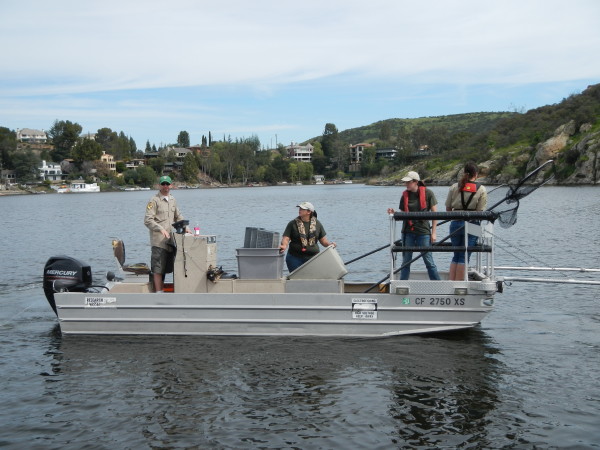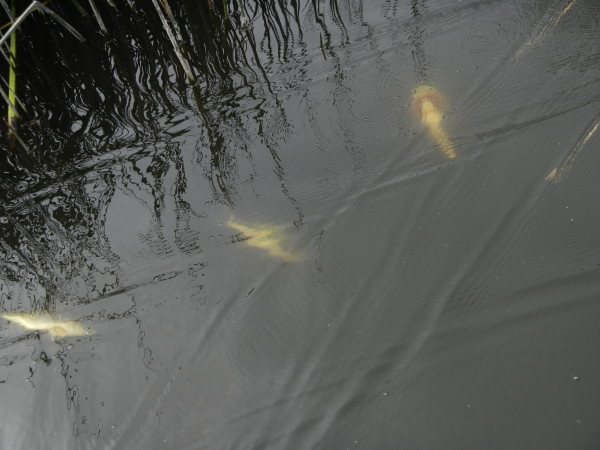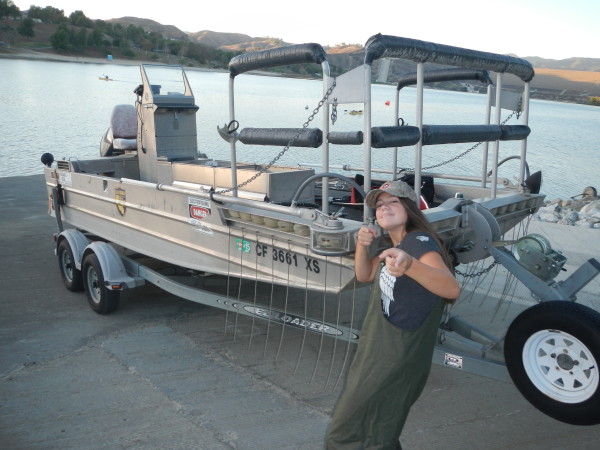The Electro Company In Action
The following appears in the December issue of California Sportsman:
By Tim E. Hovey
Russ pulled the 24-foot aluminum boat up to the lake’s dock to pick up the crew for the evening sampling. If you didn’t know what to look for, the vessel would look just like another metal skiff. But to those versed in fisheries, it screams business.
A huge part of fisheries science involves repeated surveys over time to determine the overall health of a fishery. To make an accurate assessment of population status or species composition, we depend on a consistent sampling method to collect the required data.
In small creeks or streams, we depend on seine nets and small backpack electro-shockers. However, when we need to assess larger bodies of water and survey on a broader scale, we rely on the workhorse in our survey toolbox: the electro-fishing boat.
THE BASICS
Several structures on the vessel separate it from the average boat. The center console sits further back and an elevated captain’s seat gives the pilot a good view of all the action that occurs at the front of the vessel. The front of the rectangular boat is framed by a high rail and an elevated platform so that netters can stay safe and can see down into the water at the front of the craft. Down the center of the boat are a series of tanks and work stations for collecting data, measuring and weighing fish, and keeping fish alive while they’re being worked on. A bank of high-intensity floodlights line the front of the skiff to light up the section of sampling water at the front of the boat.
When the Smith-Root electro-fishing boat is traveling to the sample area, it really does look like a regular vessel. But once it’s time for work, the boat undergoes a slight transformation. Twelve-foot conductor rods are rotated from the side of the craft to the front, pivoting on the front corners. At the tip of each rod is a circular, electrical array with heavy-wire conductors that sit partially submerged in the water.
When extended to the front and ready to sample, a generator mounted behind the pilot brings power to the extended arrays. Pressure-powered pedals turn the unit on and off at the front of the boat and are manned by the front netters. When the boat is sampling, the front conductors electrify the water all around the front and sides of the vessel, stunning any fish within the vicinity. Electrical settings are adjusted so that the fish are usually only temporarily affected by the current.
Electro-fishing boats are used for a variety of fisheries science reasons. They’re predominantly used on larger bodies of water when other sampling techniques are not practical or difficult to use. They are also used to perform large fish-sampling jobs and to collect large amounts of fisheries data quickly.
HOW THEY DO IT
To maintain lake and reservoir health, biologists will conduct several different types of surveys to collect specific data. Using the electro-fishing boat, the captain will steer the vessel towards shore and the netters will initiate the current by hitting the foot pedals.
Running the boat parallel to shore and slowly around the perimeter, the netters will collect all the fish that “turn” or are incapacitated by the current. Netted fish are deposited into the deck tanks to be identified, measured and weighed. After the fish are worked up, they are released at the side of the boat unharmed.
Safety – for both the fish and biologists – is a priority. We have a pretty strict safety protocol to never reach over the side of the boat and into the water to keep from getting shocked. I have never seen anyone shocked, but I’m sure the protocol is in place because it has happened in the past.
And as for making sure the fish we are collecting are returned to the water after being shocked, I’ve been on dozens of these shock-boat surveys and have never seen a fish die. When dealing with big bodies of water, fish can move out of the shock pattern or are quickly collected and brought aboard. The work-up involves pulling them out of the water, weighing and measuring them. They are then released in good health.
We also have the ability to dial down the amperage to a less lethal dose to keep from injuring the fish. We essentially set the boat to stun.
The collected data can clearly illustrate the health of a larger body of water. Depending on the types and sizes of the fish collected, biologists can determine the overall fisheries health of a lake or reservoir.
Collecting only one size class of a species of fish indicates an issue with reproduction. If a lake sample only brings in larger fish, we typically conclude that for some reason – usually poor water quality or elevated water temperature – reproduction is either not occurring or something is happening to the eggs or larvae. Sometimes this will affect one species of fish or may impact all species present in the lake.
Fish in poor health or that are emaciated could indicate a lack of forage fish, a sign that a lake lacks smaller fish for larger species to feed on. This lake phase can easily be seen during sampling and collecting, and is usually verified when a length/weight profile is established once the data is analyzed.
A poor forage base in a lake will yield medium to larger fish that are below average weight, and little to no smaller fish present in the sample. Typically, a healthy lake will contain fish of all size classes, from fry to fully grown adults. The fish will be well fed and free of injuries or lesions.
Conducting electro-fishing surveys is also a great way to determine the species composition of a large body of water. An evening survey around the perimeter of the lake will usually yield all representative species.
Occasionally, we’ll use the e-fishing boats to survey, collect or remove species that may be detrimental to California inland waters. We use the large sampling current to verify the presence of certain species that may disrupt a normal reservoir ecosystem or would be hazardous to downstream species.
BIOLOGISTS IN ACTION
Last month I got the opportunity to take my oldest daughter, Alyssa, on a reservoir survey of one of the local lakes using an electro-fishing boat. This particular survey involved a population assessment and would involve collecting all species of fish, depositing them into the deck tanks and then weighing and measuring them. The survey plan involved shocking the perimeter of the lake.
We spent the evening shocking near the shores and collected largemouth bass, crappie, common carp, bluegill and catfish. For the first part of the evening Alyssa and I were the netters on the front of the boat, running the shocker and collecting the fish. The highlight was Alyssa netting a 20-pound carp and wrestling it into the onboard tank.
Later in the evening we switched tasks to fish measuring and data collecting. Alyssa weighed and measured the collected fish and I recorded the data. Throughout the evening she got a feel for how fisheries biologists conduct field research and what it’s like to work in the fisheries field.
When we were back on the dock we helped load the boat on the trailer and cleaned up the sampling gear. By the time we got back in the truck to head home, Alyssa was worn out but had really enjoyed the experience.
THE BEST WAY TO LEARN
In some cases, utilizing technology like electro-fishing to collect biological fisheries data can be considered a convenience. When it comes to assessing species composition and population health of lakes and reservoirs, using electro-fishing vessels is really the only way to achieve accurate data sets that will result in a more precise biological conclusion.
Establishing repeatable sampling protocols via electro-shocking boats allow biologists to feel confident in their overall assessment of lake health. Without a doubt, the data collected through the use of boat electro-fishing goes a long way in making sure that local lakes and reservoirs stay healthy for everyone to enjoy. And that should keep anglers pretty charged up about our work. CS
Editor’s note: The author is a CDFW fisheries biologist.










